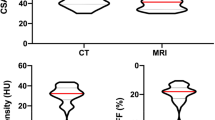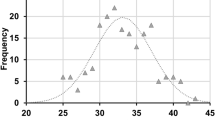Abstract
Purpose
Body composition is of great prognostic value in several severe diseases, including different types of cancer as well as cardiometabolic disorders. We aimed to investigate the correlations of skeletal muscle mass and abdominal adipose tissue compartments between volumetric and single-slice measurements to study the usefulness of several anatomical landmarks for estimation of total compartment volumes using abdominal CT-scans.
Methods
In this retrospective study volumetric quantifications of paraspinal skeletal muscles (SM) and adipose tissue compartments (visceral adipose tissue, VAT; subcutaneous adipose tissue, SAT) were performed in 50 consecutive patients (26 male; mean age, 63 ± 15 years) who underwent abdominal multislice-CT for diagnostic purposes using an in-house software. Associations between total volumes of SM, VAT, and SAT with single-slice measurements at eight predefined anatomical landmarks (median intervertebral disk spaces T12/L1 to L5/S1; level of the umbilicus (U); level of the radix of the superior mesenteric artery (SMA)) were studied using correlation coefficients.
Results
Statistical analysis revealed a strong association between single-slice measurements of adipose tissue compartments with total VAT and SAT volume (VAT: all r > 0.89, P < 0.001; SAT: all r > 0.95, P < 0.001). The strongest associations with total SM volume were found for single-slice measurements obtained at L3/4 (r = 0.94, P < 0.001) and were further improved by normalization to height (r = 0.98, P < 0.001).
Conclusions
Single-slice measurements of SM, VAT, and SAT at several anatomical landmarks are strongly associated with total compartment volumes and therefore allow for easy and simultaneous assessment of skeletal muscle mass and adipose tissue compartment volumes.




Similar content being viewed by others
Abbreviations
- BMI:
-
Body mass index
- CT:
-
Computed tomography
- ROI:
-
Region of interest
- SAT:
-
Subcutaneous adipose tissue
- SMA:
-
Superior mesenteric artery
- SM:
-
Paraspinal skeletal muscle mass
- SMVH:
-
Paraspinal skeletal muscle mass normalized to volume of interest height
- VAT:
-
Visceral adipose tissue
References
Dall TM, Gallo PD, Chakrabarti R, West T, Semilla AP, Storm MV (2013) An aging population and growing disease burden will require a large and specialized health care workforce by 2025. Health Aff 32:2013–2020.
Bjorntorp P, Bray GA, Carroll KK, Chuchalin A, Dietz WH, Ehrlich GE, et al. (2000) Obesity : preventing and managing the global epidemic. WHO Tech Rep Ser. 2000.
The GBD 2015 Obesity Collaborators (2017) Health effects of overweight and obesity in 195 countries over 25 years. N Engl J Med 377:13–27.
Fox CS, Massaro JM, Hoffmann U, Pou KM, Maurovich-Horvat P, Liu CY, et al. (2017) Abdominal visceral and subcutaneous adipose tissue compartments: association with metabolic risk factors in the framingham heart study. Circulation 116:39–48.
Nguyen GK, Mellnick VM, Yim AK-Y, Salter A, Ippolito JE (2018) Synergy of sex differences in visceral fat measured with CT and tumor metabolism helps predict overall survival in patients with renal cell carcinoma. Radiology 287:884-892.
Murray T, Williams D, Lee MJ. (2017) Osteoporosis, obesity, and sarcopenia on abdominal CT: a review of epidemiology, diagnostic criteria, and management strategies for the reporting radiologist. Abdom Radiol 42:2376-2386.
Martin L, Birdsell L, MacDonald N, Reiman T, Clandinin MT, McCargar LJ, et al. (2013) Cancer cachexia in the age of obesity: Skeletal muscle depletion is a powerful prognostic factor, independent of body mass index. J Clin Oncol 31:1539–1547.
Prado CM, Lieffers JR, McCargar LJ, Reiman T, Sawyer MB, Martin L, et al. (2008) Prevalence and clinical implications of sarcopenic obesity in patients with solid tumours of the respiratory and gastrointestinal tracts: a population-based study. Lancet Oncol 9:629–635.
Yip C, Dinkel C, Mahajan A, Siddique M, Cook GJR, Goh V (2015) Imaging body composition in cancer patients: visceral obesity, sarcopenia and sarcopenic obesity may impact on clinical outcome. Insights Imaging 6:489-497.
Lenchik L, Lenoir KM, Tan J, Boutin RD, Callahan KE, Kritchevsky SB, et al. (2018) Opportunistic measurement of skeletal muscle size and muscle attenuation on computed tomography predicts one-year mortality in Medicare patients. J Gerontol A Biol Sci Med Sci https://doi.org/10.1093/gerona/gly183.
Lenchik L, Boutin RD (2018) Sarcopenia: beyond muscle atrophy and into the new frontiers of opportunistic imaging, precision medicine, and machine learning. Semin Musculoskelet Radiol;22:307–22.
Shen W (2004) Total body skeletal muscle and adipose tissue volumes: estimation from a single abdominal cross-sectional image. J Appl Physiol 97:2333–8.
Derstine BA, Holcombe SA, Ross BE, Wang NC, Su GL, Wang SC (2018) Skeletal muscle cutoff values for sarcopenia diagnosis using T10 to L5 measurements in a healthy US population. Sci Rep 8:11369.
Irlbeck T, Massaro JM, Bamberg F, O’Donnell CJ, Hoffmann U, Fox CS (2010) Association between single-slice measurements of visceral and abdominal subcutaneous adipose tissue with volumetric measurements: The framingham heart study. Int J Obes 34:781–787.
Nattenmueller J, Hoegenauer H, Boehm J, Scherer D, Paskow M, Gigic B, et al. (2016) CT-based compartmental quantification of adipose tissue versus body metrics in colorectal cancer patients. Eur Radiol 26:4131–4140.
Homsi R, Meier-Schroers M, Gieseke J, Dabir D, Luetkens JA, Kuetting DL, et al. (2016) 3D-Dixon MRI based volumetry of peri- and epicardial fat. Int J Cardiovasc Imaging 32:291-299.
Yoshizumi T, Nakamura T, Yamane M, Waliul Islam AHM, Menju M, Yamasaki K, et al. (1999) Abdominal fat: standardized technique for measurement at CT. Radiology 211:283–286.
Crawford RJ, Filli L, Elliott JM, Nanz D, Fischer MA, Marcon M, et al. (2016) Age- and level-dependence of fatty infiltration in lumbar paravertebral muscles of healthy volunteers. Am J Neuroradiol 37:742-748.
Boutin RD, Yao L, Canter RJ, Lenchik L. (2015) Sarcopenia: Current concepts and imaging implications. Am J Roentgenol 205:W255–266.
Crawford RJ, Cornwall J, Abbott R, Elliott JM. (2017) Manually defining regions of interest when quantifying paravertebral muscles fatty infiltration from axial magnetic resonance imaging: a proposed method for the lumbar spine with anatomical cross-reference. BMC Musculoskelet Disord 18:25.
Schlaeger S, Inhuber S, Rohrmeier A, Dieckmeyer M, Freitag F, Klupp E, et al. (2018) Association of paraspinal muscle water–fat MRI-based measurements with isometric strength measurements. Eur Radiol https://doi.org/10.1007/s00330-018-5631-8.
Dahlqvist JR, Vissing CR, Hedermann G, Thomsen C, Vissing J (2017) Fat replacement of paraspinal muscles with aging in healthy adults. Med Sci Sports Exerc 49:595-601.
Teichtahl AJ, Urquhart DM, Wang Y, Wluka AE, Wijethilake P, O’Sullivan R, et al. (2015) Fat infiltration of paraspinal muscles is associated with low back pain, disability, and structural abnormalities in community-based adults. Spine J 15:1593-1601.
Otemuyiwa B, Derstine BA, Zhang P, Wong SL, Sabel MS, Redman BG, et al. (2017) Dorsal muscle attenuation may predict failure to respond to Interleukin-2 therapy in metastatic renal cell carcinoma. Acad Radiol 24:1094-1100.
Canvasser LD, Mazurek AA, Cron DC, Terjimanian MN, Chang ET, Lee CS, et al. (2014) Paraspinous muscle as a predictor of surgical outcome. J Surg Res 192:76-81.
Praktiknjo M, Book M, Luetkens J, Pohlmann A, Meyer C, Thomas D, et al. (2018) Fat-free muscle mass in magnetic resonance imaging predicts acute-on-chronic liver failure and survival in decompensated cirrhosis. Hepatology 67:1014–1026.
St-Onge M-P (2005) Relationship between body composition changes and changes in physical function and metabolic risk factors in aging. Curr Opin Clin Nutr Metab Care 8:523-528.
Goodpaster BH, Park SW, Harris TB, Kritchevsky SB, Nevitt M, Schwartz A V., et al. (2006) The loss of skeletal muscle strength, mass, and quality in older adults: The Health, Aging and Body Composition Study. J Gerontol A Biol Sci Med Sci 61:1059-1064.
Heymsfield SB, Gonzalez MC, Lu J, Jia G, Zheng J (2015) Skeletal muscle mass and quality: Evolution of modern measurement concepts in the context of sarcopenia. Proc Nutr Soc 74:355–366.
Author information
Authors and Affiliations
Corresponding author
Additional information
Publisher's Note
Springer Nature remains neutral with regard to jurisdictional claims in published maps and institutional affiliations.
Rights and permissions
About this article
Cite this article
Faron, A., Luetkens, J.A., Schmeel, F.C. et al. Quantification of fat and skeletal muscle tissue at abdominal computed tomography: associations between single-slice measurements and total compartment volumes. Abdom Radiol 44, 1907–1916 (2019). https://doi.org/10.1007/s00261-019-01912-9
Published:
Issue Date:
DOI: https://doi.org/10.1007/s00261-019-01912-9




